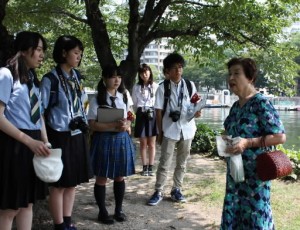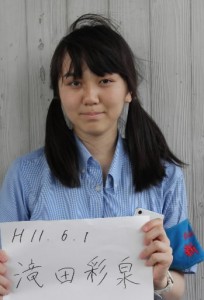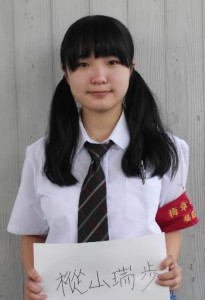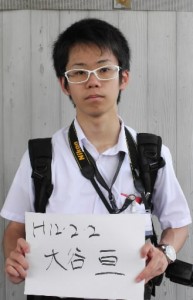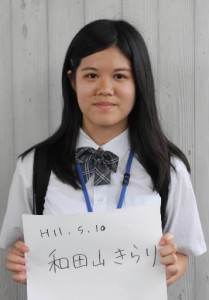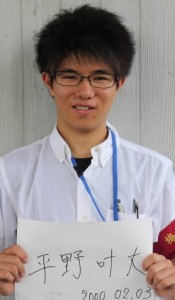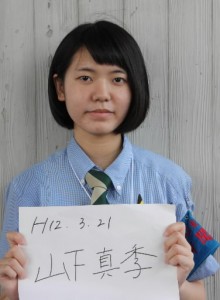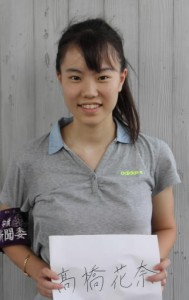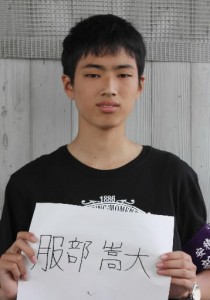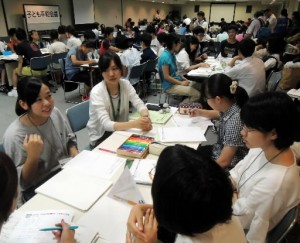Peace Seeds: Teens in Hiroshima Sow Seeds of Peace (Part 35)
Aug. 18, 2016
Part 35: Summer of teens learning about the A-bombed city
This year Hiroshima marked the 71st anniversary of the atomic bombing. During the summer, a large number of people, from in and out of Japan, visited the A-bombed city. Among them were teens who came from beyond Hiroshima Prefecture. What do these teens feel when they visit Hiroshima and what do they want to tell others about their experience here? The junior writers interviewed two groups of young people through an exchange of views and a survey.
One group consisted of eight newspaper club members from four high schools in Fukushima Prefecture. Together with them, we visited the Peace Memorial Museum and the Peace Memorial Park, listened to the account of an A-bomb survivor and shared ideas about the atomic bombing and the accident at the nuclear power plant in Fukushima, particularly in connection with handing down these memories.
The other group was composed of young people, from elementary school students to college students, visiting Hiroshima from prefectures that included Hokkaido and Oita. These students were participants of the “Children’s Peace Conference,” an event organized by the Japanese Consumers’ Co-operative Union and other groups. A total of 121 young people, including 12 junior writers, shared what they have learned about war from their local areas and discussed the actions they can take.
Exchanging our views and expressing our own ideas have deepened our thoughts on this subject. We would like to convey the issues of Hiroshima and Fukushima by holding the history of war, in various locations, firmly in mind.
Voices for peace: Four high school newspaper clubs in Fukushima Prefecture
Eight members from four high school newspaper clubs in Fukushima Prefecture and 12 junior writers of high school age visited the Peace Memorial Museum and listened to the A-bomb account of Chiyuki Kakei, 87, a resident of Higashihiroshima, who experienced the Hiroshima bombing when she was 16 years old. The four high schools in Fukushima Prefecture include Asaka Senior High School in Koriyama; Koriyama-higashi Senior High School in Koriyama; Soma Senior High School in Soma; and Fukushima Senior High School in the city of Fukushima. We also discussed issues involving the atomic bombing of Hiroshima and the nuclear accident in Fukushima, which occurred at the Fukushima No. 1 (Daiichi) nuclear power plant.
We split into four groups to exchange views. During our discussion, we posed questions about the earthquake that struck five years ago and the accident at the nuclear power plant. Ayami Takita, 17, a second-year student at Koriyama-higashi High School, was in fifth grade in elementary school at the time. Back then, she was unable to grasp the seriousness of the situation and felt burdened by having to wear a device around her neck each day to measure her radiation exposure.
Buried under the grounds of Soma High School is contaminated soil that was removed when the area was decontaminated. Although students of the high school are outside on school grounds for their club activities, “We aren’t conscious of this on a daily basis,” said Wataru Ogai, 16, a second-year student at the school. Takahiro Hattori, 15, a first-year student at Asaka High School, called on us all to “Face these situations with a cool head, if there are unexpected disasters like an earthquake or a nuclear accident.”
In her A-bomb account, Ms. Kakei said that her parents perished while at home, which was located in the Tenjin-cho district of Hiroshima. This area is now part of the Peace Memorial Park. As well as losing her parents, she lost her home, and so, quite suddenly, she was forced to live with relatives.
Maki Yamashita, 16, a second-year student at Koriyama-higashi High School, pointed out that “Even now, five years later, there are people who are unable to return to their homes in Fukushima.” Ms. Kakei said, “In Hiroshima, people began building their own shacks and they improved their living spaces, little by little, when their lives got better. I hope that the people now living in temporary housing, who are feeling unhappy over this situation, will be able to own new homes.”
Kanata Hirano, 16, a second-year student at Fukushima High School, asked Ms. Kakei, “What should be done to maintain peace?” Ms. Kakei responded, “The voting age was recently lowered to 18 so I encourage you to make your voices heard by the government. During the war, our opinion wasn’t even considered.”
The strength of citizens in Hiroshima and Fukushima
Ayami Takita, 17, second-year student at Koriyama-higashi High School: In Fukushima, many people perceive the accident at the nuclear power plant as a thing of the past. But here, the issue of Hiroshima has been handed down for the past 71 years. I would like to interview people who are unable to return to their homes because of the nuclear accident.
Mizuho Momiyama, 17, second-year student at Fukushima High School: Living with radiation has become part of our daily lives so this issue is no longer a topic of conversation. I would like more opportunities to hear first-hand the stories of people who live in the Hamadori district by the Pacific Ocean [an area that was hit hard by the nuclear accident].
Wataru Ogai, 16, second-year student at Soma High School: I saw kindergarten children looking at the A-bombed Aogiri tree in the Peace Memorial Park. I learned that the people of Hiroshima are strongly aware of peace issues.
Kirari Wadayama, 17, second-year student at Soma High School: I saw a full-size replica of the atomic bomb on display at the Peace Memorial Museum. Nearby was a panorama of the devastated city after the atomic bombing. When I saw these things, I recognized clearly that just a small bomb destroyed the entire city.
Kanata Hirano, 16, second-year student at Fukushima High School: I had assumed that the Japanese government was responsible for reconstructing the city. But I now realize that the strength of Hiroshima citizens was essential. I would like to help change our way of thinking in Fukushima so that the people there can figure out their own way forward, rather than relying on the government.
Maki Yamashita, 16, second-year student at Koriyama-higashi High School: The experiences of people in Hiroshima, including Ms. Kakei, were so tragic it’s hard for us to imagine that sort of suffering.
Kana Takahashi, 16, second-year student at Asaka High School: I was surprised to see that, 71 years after the atomic bombing, so many people continue visit the A-bomb Dome. I would like to gather information that only those who live in areas devastated by the earthquake can give us.
Takahiro Hattori, 15, first-year student at Asaka High School: After visiting the Peace Memorial Museum, I think it’s important to convey the stories of this tragedy to people who have no experience of this.
Report on the Children’s Peace Conference
At this conference, the participants, ranging from elementary school students to high school students, were divided into 17 groups. Each group, based on grade level, consisted of five to seven members. With college students serving as facilitators, the groups discussed what young people can do to help abolish nuclear weapons and conflict, including war. After this discussion, the groups reported on their findings and an appeal was made by all the participants.
The groups of elementary school students said such things as: “We should respect the opinions of others.” “We mustn’t do things that we don’t want others to do.” “We should apologize when we’re wrong.” “We should help people in need.”
The groups of junior high school students said: “We should help prevent bullying.” “We have to stop global warming.” “We should carefully preserve things connected to the war.” “We have to vote when we’re old enough.”
The groups of high school students said: “We must learn about the history of the war from the perspective of both those who suffered and those who were the aggressor.” “We must not act with indifference.” “We should share information through gatherings and through social networking.”
Based on these findings, the participants drafted an appeal. Tokitsuna Kawagishi, a junior writer and a third-year junior high school student, served as chairperson and declared: “We will help create a bright future where people can hold hands with others from various nations who hold various ideas.”
Survey responses from 100 participants
We also conducted a survey of the participants. Of the 121 participants of the Children’s Peace Conference, 100 teens responded to this survey (47 elementary school students, 32 junior high school students, 20 high school students, and one college student).
Who do you want to tell about the issues involving Hiroshima, and what will you tell them?
Sixty-eight people said that they would like to talk about Hiroshima with their parents and siblings, and 44 people said they would like to talk about this with friends and fellow students at school. (Multiple answers were allowed.)
They want to tell people about the horror and destruction of the atomic bombing and the war, as well as the preciousness of peace. About 20 percent added that they would like to share the things that were discussed at the Children’s Peace Conference. A sixth grader from an elementary school in Kawasaki wrote: “I would like to convey the idea that we’re now able to live in peace because of the efforts made in the past by the people who came before us.” A first-year student from a high school in Sapporo said: “Along with the horror of war, I would like to tell them about Hiroshima today and how the city was reconstructed after the devastation of the atomic bombing.”
Are you aware that U.S. President Barack Obama recently visited Hiroshima?
Ninety-five percent said that they know about President Obama’s visit to Hiroshima. All the respondents in junior high school and above said that they were aware of this fact.
Regarding the question “What would you like the president to do now?”, 34 people, or about one-third of the respondents, said “I want the president to convey what happened in Hiroshima and the importance of peace to the world,” and “I want the president to prevent war and promote a peaceful world.” Some students said “I want the president to visit Hiroshima again” and “I want the president to visit Nagasaki,” expressing their hope that the president will again come to the A-bombed cities. Their voices indicate a high degree of interest in the visit to Hiroshima by Mr. Obama this past May.
A sixth grader from an elementary school in Yamagata Prefecture wrote: “It is important to solve problems through dialogue rather than through force.”
What places do you recommend for peace education?
These places were recommended as sites for pursuing peace education activities: Remains of Hokkaido Air Raids (Sapporo City and other places, Hokkaido); Northern Territories Museum (Shibetu Town, Hokkaido); Cape Nosappu (Nemuro City, Hokkaido); National Showa Memorial Museum (Chiyoda Ward, Tokyo); Yokohama Foreign General Cemetery (Naka Ward, Yokohama City, Kanagawa); NKY Hikawamaru (Naka Ward, Yokohama City, Kanagawa); Kawasaki Peace Museum (Nakahara Ward, Kawasaki City, Kanagawa); U.S. military bases (Yamato City, Ayase City, Yokosuka City, Sagamihara City and others, Kanagawa); Development Center for Children’s Futures (Toyohashi City, Aichi); Okayama City Museum (Kita Ward, Okayama); A-bomb Dome (Naka Ward, Hiroshima); Peace Memorial Park (Naka Ward, Hiroshima); Peace Memorial Museum (Naka Ward, Hiroshima); Remains of Hiroshima Imperial Headquarters (Naka Ward, Hiroshima); Kaiten Memorial Museum (Shunan City, Yamaguchi); Mutsu Memorial Museum (Suo-oshima Town, Yamaguchi); Joi No. 1 Bunker (Usa City, Oita); Atomic Bomb Museum (Nagasaki City); Peace Memorial Park (Nagasaki City); Nyokodo Hall (Nagasaki City); A-bombed Camphor Tree (Sanno Shrine, Nagasaki City); One-legged Torii Gate (Sanno Shrine, Nagasaki City).
Shino Taniguchi, Takeshi Iwata, Harumi Okada, Maiko Hanaoka, Kana Fukushima (third-year high school students); Marika Tsuboki, Nozomi Mizoue, Chiaki Yamada (second-year high school students); Miyu Okada, Midori Nakagawa, Hisashi Iwata, Shunichi Kamichoja, Kana Okino (first-year high school students); Tokitsuna Kawagishi, Riho Kito, Ai Mizoue, Anna Primus (third-year junior high school students); Kotoori Kagagishi, Akane Sato (second-year junior high school students); and Yui Morimoto (first-year junior high school student) contributed to this article.
What is Peace Seeds?
Peace Seeds are the seeds of smiles which can be spread around the world by thinking about peace and the preciousness of life from various viewpoints. To fill this world with flowering smiles, 39 junior writers, from the first year of junior high school to the third year of senior high school, choose themes, gather information, and write articles.
(Originally published on August 18, 2016)
This year Hiroshima marked the 71st anniversary of the atomic bombing. During the summer, a large number of people, from in and out of Japan, visited the A-bombed city. Among them were teens who came from beyond Hiroshima Prefecture. What do these teens feel when they visit Hiroshima and what do they want to tell others about their experience here? The junior writers interviewed two groups of young people through an exchange of views and a survey.
One group consisted of eight newspaper club members from four high schools in Fukushima Prefecture. Together with them, we visited the Peace Memorial Museum and the Peace Memorial Park, listened to the account of an A-bomb survivor and shared ideas about the atomic bombing and the accident at the nuclear power plant in Fukushima, particularly in connection with handing down these memories.
The other group was composed of young people, from elementary school students to college students, visiting Hiroshima from prefectures that included Hokkaido and Oita. These students were participants of the “Children’s Peace Conference,” an event organized by the Japanese Consumers’ Co-operative Union and other groups. A total of 121 young people, including 12 junior writers, shared what they have learned about war from their local areas and discussed the actions they can take.
Exchanging our views and expressing our own ideas have deepened our thoughts on this subject. We would like to convey the issues of Hiroshima and Fukushima by holding the history of war, in various locations, firmly in mind.
Voices for peace: Four high school newspaper clubs in Fukushima Prefecture
Eight members from four high school newspaper clubs in Fukushima Prefecture and 12 junior writers of high school age visited the Peace Memorial Museum and listened to the A-bomb account of Chiyuki Kakei, 87, a resident of Higashihiroshima, who experienced the Hiroshima bombing when she was 16 years old. The four high schools in Fukushima Prefecture include Asaka Senior High School in Koriyama; Koriyama-higashi Senior High School in Koriyama; Soma Senior High School in Soma; and Fukushima Senior High School in the city of Fukushima. We also discussed issues involving the atomic bombing of Hiroshima and the nuclear accident in Fukushima, which occurred at the Fukushima No. 1 (Daiichi) nuclear power plant.
We split into four groups to exchange views. During our discussion, we posed questions about the earthquake that struck five years ago and the accident at the nuclear power plant. Ayami Takita, 17, a second-year student at Koriyama-higashi High School, was in fifth grade in elementary school at the time. Back then, she was unable to grasp the seriousness of the situation and felt burdened by having to wear a device around her neck each day to measure her radiation exposure.
Buried under the grounds of Soma High School is contaminated soil that was removed when the area was decontaminated. Although students of the high school are outside on school grounds for their club activities, “We aren’t conscious of this on a daily basis,” said Wataru Ogai, 16, a second-year student at the school. Takahiro Hattori, 15, a first-year student at Asaka High School, called on us all to “Face these situations with a cool head, if there are unexpected disasters like an earthquake or a nuclear accident.”
In her A-bomb account, Ms. Kakei said that her parents perished while at home, which was located in the Tenjin-cho district of Hiroshima. This area is now part of the Peace Memorial Park. As well as losing her parents, she lost her home, and so, quite suddenly, she was forced to live with relatives.
Maki Yamashita, 16, a second-year student at Koriyama-higashi High School, pointed out that “Even now, five years later, there are people who are unable to return to their homes in Fukushima.” Ms. Kakei said, “In Hiroshima, people began building their own shacks and they improved their living spaces, little by little, when their lives got better. I hope that the people now living in temporary housing, who are feeling unhappy over this situation, will be able to own new homes.”
Kanata Hirano, 16, a second-year student at Fukushima High School, asked Ms. Kakei, “What should be done to maintain peace?” Ms. Kakei responded, “The voting age was recently lowered to 18 so I encourage you to make your voices heard by the government. During the war, our opinion wasn’t even considered.”
The strength of citizens in Hiroshima and Fukushima
Ayami Takita, 17, second-year student at Koriyama-higashi High School: In Fukushima, many people perceive the accident at the nuclear power plant as a thing of the past. But here, the issue of Hiroshima has been handed down for the past 71 years. I would like to interview people who are unable to return to their homes because of the nuclear accident.
Mizuho Momiyama, 17, second-year student at Fukushima High School: Living with radiation has become part of our daily lives so this issue is no longer a topic of conversation. I would like more opportunities to hear first-hand the stories of people who live in the Hamadori district by the Pacific Ocean [an area that was hit hard by the nuclear accident].
Wataru Ogai, 16, second-year student at Soma High School: I saw kindergarten children looking at the A-bombed Aogiri tree in the Peace Memorial Park. I learned that the people of Hiroshima are strongly aware of peace issues.
Kirari Wadayama, 17, second-year student at Soma High School: I saw a full-size replica of the atomic bomb on display at the Peace Memorial Museum. Nearby was a panorama of the devastated city after the atomic bombing. When I saw these things, I recognized clearly that just a small bomb destroyed the entire city.
Kanata Hirano, 16, second-year student at Fukushima High School: I had assumed that the Japanese government was responsible for reconstructing the city. But I now realize that the strength of Hiroshima citizens was essential. I would like to help change our way of thinking in Fukushima so that the people there can figure out their own way forward, rather than relying on the government.
Maki Yamashita, 16, second-year student at Koriyama-higashi High School: The experiences of people in Hiroshima, including Ms. Kakei, were so tragic it’s hard for us to imagine that sort of suffering.
Kana Takahashi, 16, second-year student at Asaka High School: I was surprised to see that, 71 years after the atomic bombing, so many people continue visit the A-bomb Dome. I would like to gather information that only those who live in areas devastated by the earthquake can give us.
Takahiro Hattori, 15, first-year student at Asaka High School: After visiting the Peace Memorial Museum, I think it’s important to convey the stories of this tragedy to people who have no experience of this.
Report on the Children’s Peace Conference
At this conference, the participants, ranging from elementary school students to high school students, were divided into 17 groups. Each group, based on grade level, consisted of five to seven members. With college students serving as facilitators, the groups discussed what young people can do to help abolish nuclear weapons and conflict, including war. After this discussion, the groups reported on their findings and an appeal was made by all the participants.
The groups of elementary school students said such things as: “We should respect the opinions of others.” “We mustn’t do things that we don’t want others to do.” “We should apologize when we’re wrong.” “We should help people in need.”
The groups of junior high school students said: “We should help prevent bullying.” “We have to stop global warming.” “We should carefully preserve things connected to the war.” “We have to vote when we’re old enough.”
The groups of high school students said: “We must learn about the history of the war from the perspective of both those who suffered and those who were the aggressor.” “We must not act with indifference.” “We should share information through gatherings and through social networking.”
Based on these findings, the participants drafted an appeal. Tokitsuna Kawagishi, a junior writer and a third-year junior high school student, served as chairperson and declared: “We will help create a bright future where people can hold hands with others from various nations who hold various ideas.”
Survey responses from 100 participants
We also conducted a survey of the participants. Of the 121 participants of the Children’s Peace Conference, 100 teens responded to this survey (47 elementary school students, 32 junior high school students, 20 high school students, and one college student).
Who do you want to tell about the issues involving Hiroshima, and what will you tell them?
Sixty-eight people said that they would like to talk about Hiroshima with their parents and siblings, and 44 people said they would like to talk about this with friends and fellow students at school. (Multiple answers were allowed.)
They want to tell people about the horror and destruction of the atomic bombing and the war, as well as the preciousness of peace. About 20 percent added that they would like to share the things that were discussed at the Children’s Peace Conference. A sixth grader from an elementary school in Kawasaki wrote: “I would like to convey the idea that we’re now able to live in peace because of the efforts made in the past by the people who came before us.” A first-year student from a high school in Sapporo said: “Along with the horror of war, I would like to tell them about Hiroshima today and how the city was reconstructed after the devastation of the atomic bombing.”
Are you aware that U.S. President Barack Obama recently visited Hiroshima?
Ninety-five percent said that they know about President Obama’s visit to Hiroshima. All the respondents in junior high school and above said that they were aware of this fact.
Regarding the question “What would you like the president to do now?”, 34 people, or about one-third of the respondents, said “I want the president to convey what happened in Hiroshima and the importance of peace to the world,” and “I want the president to prevent war and promote a peaceful world.” Some students said “I want the president to visit Hiroshima again” and “I want the president to visit Nagasaki,” expressing their hope that the president will again come to the A-bombed cities. Their voices indicate a high degree of interest in the visit to Hiroshima by Mr. Obama this past May.
A sixth grader from an elementary school in Yamagata Prefecture wrote: “It is important to solve problems through dialogue rather than through force.”
What places do you recommend for peace education?
These places were recommended as sites for pursuing peace education activities: Remains of Hokkaido Air Raids (Sapporo City and other places, Hokkaido); Northern Territories Museum (Shibetu Town, Hokkaido); Cape Nosappu (Nemuro City, Hokkaido); National Showa Memorial Museum (Chiyoda Ward, Tokyo); Yokohama Foreign General Cemetery (Naka Ward, Yokohama City, Kanagawa); NKY Hikawamaru (Naka Ward, Yokohama City, Kanagawa); Kawasaki Peace Museum (Nakahara Ward, Kawasaki City, Kanagawa); U.S. military bases (Yamato City, Ayase City, Yokosuka City, Sagamihara City and others, Kanagawa); Development Center for Children’s Futures (Toyohashi City, Aichi); Okayama City Museum (Kita Ward, Okayama); A-bomb Dome (Naka Ward, Hiroshima); Peace Memorial Park (Naka Ward, Hiroshima); Peace Memorial Museum (Naka Ward, Hiroshima); Remains of Hiroshima Imperial Headquarters (Naka Ward, Hiroshima); Kaiten Memorial Museum (Shunan City, Yamaguchi); Mutsu Memorial Museum (Suo-oshima Town, Yamaguchi); Joi No. 1 Bunker (Usa City, Oita); Atomic Bomb Museum (Nagasaki City); Peace Memorial Park (Nagasaki City); Nyokodo Hall (Nagasaki City); A-bombed Camphor Tree (Sanno Shrine, Nagasaki City); One-legged Torii Gate (Sanno Shrine, Nagasaki City).
Shino Taniguchi, Takeshi Iwata, Harumi Okada, Maiko Hanaoka, Kana Fukushima (third-year high school students); Marika Tsuboki, Nozomi Mizoue, Chiaki Yamada (second-year high school students); Miyu Okada, Midori Nakagawa, Hisashi Iwata, Shunichi Kamichoja, Kana Okino (first-year high school students); Tokitsuna Kawagishi, Riho Kito, Ai Mizoue, Anna Primus (third-year junior high school students); Kotoori Kagagishi, Akane Sato (second-year junior high school students); and Yui Morimoto (first-year junior high school student) contributed to this article.
What is Peace Seeds?
Peace Seeds are the seeds of smiles which can be spread around the world by thinking about peace and the preciousness of life from various viewpoints. To fill this world with flowering smiles, 39 junior writers, from the first year of junior high school to the third year of senior high school, choose themes, gather information, and write articles.
(Originally published on August 18, 2016)

